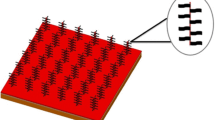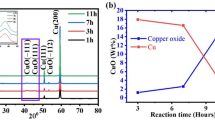Abstract
We report improved field electron emission (FEE) properties of copper oxide (CuO) nanowires (NWs) emitter by adjusting their aspect ratio, density at emitting edges, and strength of the NWs. We have grown CuO NWs by controlled morphology on copper grid via two-stage annealing process. In the first step of annealing performed at 200 °C for 2 h, creation of nucleation sites for growth of the NWs is achieved. Subsequently, a second annealing phase at 400 °C for another 2 h leads to the emergence of vertically aligned NWs. These structures are notably dense at their base, with an approximate width of 23 nm and lengths reaching several micrometers, as indicated by SEM analysis. During the FEE, the field screening effect is noticeably minimized as the NWs are quite long and well separated at apex. The turn-on field (Eon) is observed to be 4.72 V/μm (10 μA/cm2). A maximum emission current density (J) of ~ 14.11 mA/cm2 has been drawn from the emitter, at an applied field ~ 11.12 V/μm. The enhancement in the emission current density after stability is because of desorption of the gases and the presence of clean emitting sites on the emitter surface. The emission at preset value ~ 15 μA is observed to be very stable over more than 3 h. These results are the implications of unceasing quest for the development, production, and improvement of integrated field emitters based on self-supportive 1D nanostructures.







Similar content being viewed by others
Data availability
The data that support the findings of this study are available from the corresponding authors upon reasonable request.
References
J. Wu, Y.M. Qing, The enhancement of nonreciprocal radiation for light near to normal incidence with double-layer grating. Adv Compos Hybrid Mater 6, 87 (2023). https://doi.org/10.1007/s42114-023-00671-y
S.P. Gupta, P.P. Sanap, M.K. Deore et al., Molybdenum chalcogenides for supercapacitor applications: a critical review. J Energy Storage 73, 109065 (2023). https://doi.org/10.1016/j.est.2023.109065
W. Pholauyphon, R.N. Bulakhe, J. Manyam et al., Enhancing supercapacitor performance using carbon dots as versatile additives in both titanium dioxide-based electrodes and sodium sulfate electrolytes. Energy Fuels 36, 4564–4576 (2022). https://doi.org/10.1021/acs.energyfuels.2c00060
Z. Cui, J. Zhou, X. Wang et al., In situ growth of bimetallic nickel cobalt sulfide (NiCo2S4) nanowire arrays encapsulated by nitrogen-doped carbon on carbon cloth as binder-free and flexible electrode for high-performance aqueous Zn batteries. Adv Compos Hybrid Mater 6, 95 (2023). https://doi.org/10.1007/s42114-023-00668-7
C.S. Bin, J.S. Meena, J. Joo, J.-W. Kim, Autonomous self-healing wearable flexible heaters enabled by innovative MXene/polycaprolactone composite fibrous networks and silver nanowires. Adv Compos Hybrid Mater 6, 227 (2023). https://doi.org/10.1007/s42114-023-00809-y
R.M. Schofield, B.M. Maciejewska, S. Dong et al., Driving fiber diameters to the limit: nanoparticle-induced diameter reductions in electrospun photoactive composite nanofibers for organic photovoltaics. Adv Compos Hybrid Mater 6, 229 (2023). https://doi.org/10.1007/s42114-023-00788-0
W. Li, A. Meredov, A. Shamim, Coat-and-print patterning of silver nanowires for flexible and transparent electronics. NPJ Flex Electron 3, 19 (2019). https://doi.org/10.1038/s41528-019-0063-3
K. Peng, M.B. Johnston, The application of one-dimensional nanostructures in terahertz frequency devices. Appl. Phys. Rev. 8, 41314 (2021). https://doi.org/10.1063/5.0060797
L.-B. Luo, X.-H. Wang, C. Xie et al., One-dimensional CuO nanowire: synthesis, electrical, and optoelectronic devices application. Nanoscale Res. Lett. 9, 637 (2014). https://doi.org/10.1186/1556-276X-9-637
S. Cui, H. Liu, L. Gan et al., Fabrication of low-dimension nanostructures based on organic conjugated molecules. Adv. Mater. 20, 2918–2925 (2008). https://doi.org/10.1002/adma.200800619
W.I. Milne, K.B.K. Teo, G.A.J. Amaratunga et al., Carbon nanotubes as field emission sources. J. Mater. Chem. 14, 933–943 (2004). https://doi.org/10.1039/B314155C
L. Chen, H. Yu, J. Zhong et al., Graphene field emitters: a review of fabrication, characterization and properties. Mater. Sci. Eng. B 220, 44–58 (2017). https://doi.org/10.1016/j.mseb.2017.03.007
B. Das, B. Das, N. Sankar Das et al., Enhanced field emission properties of rGO wrapped Ga2O3 micro/nanobricks: Experimental investigation with theoretical validation. J. Alloys Compd. 902, 163726 (2022). https://doi.org/10.1016/j.jallcom.2022.163726
G.M. Viskadouros, M.M. Stylianakis, E. Kymakis, E. Stratakis, Enhanced field emission from reduced graphene oxide polymer composites. ACS Appl. Mater. Interfaces 6, 388–393 (2014). https://doi.org/10.1021/am4044618
Y. Wang, S. Li, H. Shi, K. Yu, Facile synthesis of p-type Cu2O/n-type ZnO nano-heterojunctions with novel photoluminescence properties, enhanced field emission and photocatalytic activities. Nanoscale 4, 7817–7824 (2012). https://doi.org/10.1039/C2NR32797J
W.-Y. Sung, W.-J. Kim, S.-M. Lee et al., Field emission characteristics of CuO nanowires by hydrogen plasma treatment. Vacuum 81, 851–856 (2007). https://doi.org/10.1016/j.vacuum.2006.10.002
Z. Lin, P. Zhao, P. Ye et al., Maximum field emission current density of CuO nanowires: theoretical study using a defect-related semiconductor field emission model and in situ measurements. Sci. Rep. 8, 2131 (2018). https://doi.org/10.1038/s41598-018-20575-y
A.S. Zoolfakar, R.A. Rani, A.J. Morfa et al., Nanostructured copper oxide semiconductors: a perspective on materials, synthesis methods and applications. J Mater Chem C 2, 5247–5270 (2014). https://doi.org/10.1039/C4TC00345D
D. Wang, H. Yang, J. Yang et al., Efficient visible light-induced photodegradation of industrial lignin using silver-CuO catalysts derived from Cu-metal organic framework. Adv Compos Hybrid Mater 6, 138 (2023). https://doi.org/10.1007/s42114-023-00708-2
R.N. Bulakhe, A.B. Bhalerao, I. In, Mixed transition metal oxides for energy applications, in Chemically Deposited Nanocrystalline Metal Oxide Thin Films: Synthesis, Characterizations, and Applications. (Springer, 2021)
W.M. Li, J.F. Zhao, L.P. Cao et al., Superconductivity in a unique type of copper oxide. Proc. Natl. Acad. Sci. 116, 12156–12160 (2019). https://doi.org/10.1073/pnas.1900908116
S.G. Sayyed, A.V. Shaikh, U.P. Shinde et al., Copper oxide-based high-performance symmetric flexible supercapacitor: potentiodynamic deposition. J. Mater. Sci. Mater. Electron. 34, 1361 (2023). https://doi.org/10.1007/s10854-023-10738-7
C. Tang, X. Liao, W. Zhong et al., Electric field assisted growth and field emission properties of thermally oxidized CuO nanowires. RSC Adv. 7, 6439–6446 (2017). https://doi.org/10.1039/C6RA27426A
A.S. Ethiraj, D.J. Kang, Synthesis and characterization of CuO nanowires by a simple wet chemical method. Nanoscale Res. Lett. 7, 70 (2012). https://doi.org/10.1186/1556-276X-7-70
S. Felix, R.B.P. Chakkravarthy, A.N. Grace, Microwave assisted synthesis of copper oxide and its application in electrochemical sensing. IOP Conf Ser Mater Sci Eng 73, 12115 (2015). https://doi.org/10.1088/1757-899X/73/1/012115
Y.W. Zhu, T. Yu, F.C. Cheong et al., Large-scale synthesis and field emission properties of vertically oriented CuO nanowire films. Nanotechnology 16, 88 (2005). https://doi.org/10.1088/0957-4484/16/1/018
M. Košiček, J. Zavašnik, O. Baranov et al., Understanding the growth of copper oxide nanowires and layers by thermal oxidation over a broad temperature range at atmospheric pressure. Cryst. Growth Des. 22, 6656–6666 (2022). https://doi.org/10.1021/acs.cgd.2c00863
Q.I. Rahman, A. Ali, N. Ahmad et al., Synthesis and characterization of CuO rods for enhanced visible light driven dye degradation. J. Nanosci. Nanotechnol. 20, 7716–7723 (2020). https://doi.org/10.1166/jnn.2020.18713
S.S. Warule, N.S. Chaudhari, B.B. Kale et al., Controlled synthesis of aligned Bi2S3 nanowires, sharp apex nanowires and nanobelts with its morphology dependent field emission investigations. CrystEngComm 15, 890–896 (2013). https://doi.org/10.1039/C2CE26588E
X. Jiang, T. Herricks, Y. Xia, CuO nanowires can be synthesized by heating copper substrates in air. Nano Lett. 2, 1333–1338 (2002). https://doi.org/10.1021/nl0257519
P.-H. Shih, S.Y. Wu, Growth mechanism studies of ZnO nanowires: experimental observations and short-circuit diffusion analysis. Nanomaterials 7, 188 (2017)
J. Shi, L. Qiao, Y. Zhao et al., Synergistic effects on thermal growth of CuO nanowires. J. Alloys Compd. 815, 152355 (2020). https://doi.org/10.1016/j.jallcom.2019.152355
Y. Yang, D. Xu, Q. Wu, P. Diao, Cu2O/CuO bilayered composite as a high-efficiency photocathode for photoelectrochemical hydrogen evolution reaction. Sci. Rep. 6, 35158 (2016). https://doi.org/10.1038/srep35158
L. Feng, H. Yan, H. Li et al., Excellent field emission properties of vertically oriented CuO nanowire films. AIP Adv. 8, 45109 (2018). https://doi.org/10.1063/1.5022320
X. Song, J. Chen, Non-crystallization and enhancement of field emission of cupric oxide nanowires induced by low-energy Ar ion bombardment. Appl. Surf. Sci. 329, 94–103 (2015). https://doi.org/10.1016/j.apsusc.2014.12.148
C.-L. Hsu, J.-Y. Tsai, T.-J. Hsueh, Novel field emission structure of CuO/Cu2O composite nanowires based on copper through silicon via technology. RSC Adv. 5, 33762–33766 (2015). https://doi.org/10.1039/C5RA03513A
S. Chatterjee, M. Kumar, A. Pal et al., The influence of surface topography on the field emission of nanostructured copper oxide thin films grown by oblique incidence deposition. J Mater Chem C 3, 6389–6394 (2015). https://doi.org/10.1039/C5TC00662G
Acknowledgements
SSW thankful to the SERB-TARE fellowship (TAR/2020/000257). Authors are also thankful to Indian Institute of Science Education and Research (IISER), Pune for the characterization support.
Funding
This work was financially supported by the SERB-TARE project (TAR/2020/ 000257) of Department of Science and Technology (DST), India. MAM would like to acknowledge the financial support from DST, Govt. of India under the CEFIPRA project 68TF-1 for carrying out Field Emission work.
Author information
Authors and Affiliations
Contributions
Conceptualization: SSG and MAM; Methodology: SSG; Formal analysis and investigation: SSG and SSW; Writing—original draft preparation: SSG, SSW, and MAM; Writing—review and editing: SSG, SSW, and MAM; Funding acquisition: SSW and MAM; Resources: SSW and MAM; Supervision: SSW and MAM.
Corresponding author
Ethics declarations
Conflict of interest
The authors declare no conflict of interest.
Ethical approval
The corresponding author consciously assure that for the manuscript “Controlled Growth of CuO Nanowires on Cu Grid via Thermal Oxidation Process with Enhanced Field Electron Emission Properties” the following is fulfilled: This material is the authors’ own original work, which has not been previously published elsewhere. The paper is not currently being considered for publication elsewhere. The paper reflects the authors’ own research and analysis in a truthful and complete manner. The paper properly credits the meaningful contributions of co-authors and co-researchers. The results are appropriately placed in the context of prior and existing research. All sources used are properly disclosed (correct citation). All authors have been personally and actively involved in substantial work leading to the paper, and will take public responsibility for its content. The author agree with the above statements and declare that this submission follows the policies of Journal of Materials Science: Materials in Electronics as outlined in the Guide for Authors and in the Ethical Statement.
Additional information
Publisher's Note
Springer Nature remains neutral with regard to jurisdictional claims in published maps and institutional affiliations.
Rights and permissions
Springer Nature or its licensor (e.g. a society or other partner) holds exclusive rights to this article under a publishing agreement with the author(s) or other rightsholder(s); author self-archiving of the accepted manuscript version of this article is solely governed by the terms of such publishing agreement and applicable law.
About this article
Cite this article
Gaikwad, S.S., Warule, S.S. & More, M.A. Controlled growth of CuO nanowires on Cu grid via thermal oxidation process with enhanced field electron emission properties. J Mater Sci: Mater Electron 35, 935 (2024). https://doi.org/10.1007/s10854-024-12683-5
Received:
Accepted:
Published:
DOI: https://doi.org/10.1007/s10854-024-12683-5




